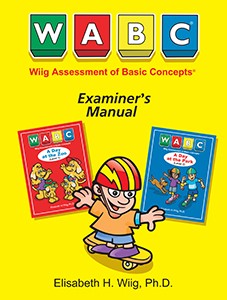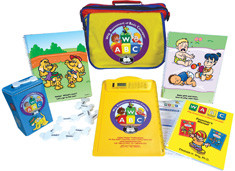Price $287.00
Contents
-

Wiig Assessment of Basic Concepts (WABC)
WABC Examiner's Manual
$58.00 -

[contains x 2]
Wiig Assessment of Basic Concepts (WABC)
WABC Level 1 Forms (25)
$47.00 -

[contains x 2]
Wiig Assessment of Basic Concepts (WABC)
WABC Level 2 Forms (25)
$47.00 -

Wiig Assessment of Basic Concepts (WABC)
WABC Level 1 Storybook
A Day at the Zoo
*Not available separately (package component only)
-

Wiig Assessment of Basic Concepts (WABC)
WABC Level 2 Storybook
A Day at the Park
*Not available separately (package component only)
-

Wiig Assessment of Basic Concepts (WABC)
WABC Puppy Bank Reinforcer
*Not available separately (package component only)
-

Wiig Assessment of Basic Concepts (WABC)
WABC Doggie Dog Tokens (30)
*Not available separately (package component only)
-

Wiig Assessment of Basic Concepts (WABC)
WABC Tote Bag
*Not available separately (package component only)
- Create focused IEPs and intervention plans.
- Thoroughly assess basic concepts.
- Identify children in preschool and kindergarten who need "extra help" with basic concepts.
- Distinguish deficits in using basic concepts from deficits in understanding them.
- Further distinguish an inability to understand basic concept terms from deficits in auditory processing (following directions).
- There is no easel. Instead, the test presents an interactive storybook format. This gives you the opportunity to test the child in a setting that is quite natural to most children (looking at/reading a book).
- The WABC embeds concept pairs or related words in colorfully illustrated scenes. Instead of presenting each concept as an unrelated single word, the WABC assesses one of the concepts in a pair receptively (Which bear is big? Child points to big bear) and the other expressively (You showed me big. This bear is…Child says, "little." )
- The WABC contains two age-level tests. Level 1 – A Day at the Zoo is for preschool children ages 2;6 to 5;11 years, and Level 2 – A Day at the Park is for children in kindergarten and early elementary grades ages 5;0 to 7;11 years. For a more complete picture of strengths and weaknesses, you may administer BOTH levels to children between 5;0 and 5;11 years.
- Color or Shape (Ex., red, square)
- Size, Weight or Volume (Ex., short/tall, big/little)
- Distance, Time or Speed (Ex., far/near, slow/fast)
- Quantity or Completeness (Ex., none/all, less/more)
- Location or Direction (Ex., behind/in front)
- Condition or Quality (Ex., hot/cold, wet/dry)
- Sensation, Emotion, or Evaluation (Ex., bad/good)

 Proud to be Canadian
Proud to be Canadian